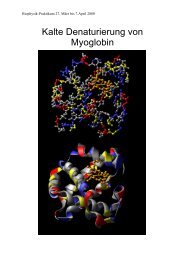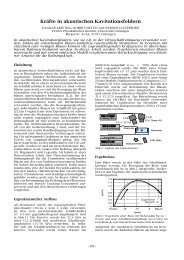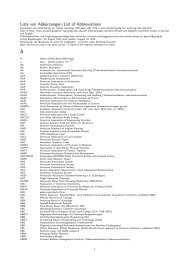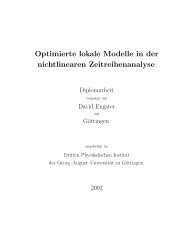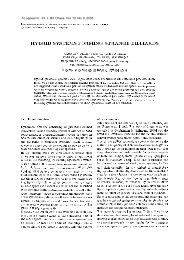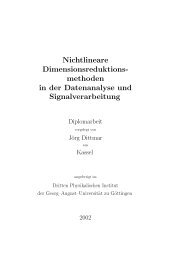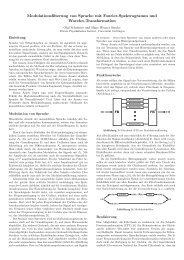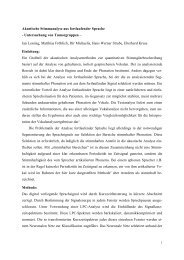Translational instability of a spherical bubble in a standing ...
Translational instability of a spherical bubble in a standing ...
Translational instability of a spherical bubble in a standing ...
Create successful ePaper yourself
Turn your PDF publications into a flip-book with our unique Google optimized e-Paper software.
ubbles translat<strong>in</strong>g <strong>in</strong> stand<strong>in</strong>g waves, either towardsa pressure ant<strong>in</strong>ode, or towards a node. In thecomputations it is essential to simulate a cont<strong>in</strong>uouspressure sweep by keep<strong>in</strong>g the previously calculated<strong>bubble</strong> state as <strong>in</strong>itial condition for the next parameterstep. It will be seen that <strong>in</strong> particular the region<strong>of</strong> the (nonl<strong>in</strong>early distorted) ma<strong>in</strong> resonanceexhibits an extended area <strong>of</strong> hysteresis, and that thiscan result <strong>in</strong> the absence <strong>of</strong> positional equilibria, i.e.,zeros <strong>of</strong> the primary Bjerknes force.Figure 1 presents the overviews <strong>in</strong> the P ex,a − R 0parameter plane for driv<strong>in</strong>g frequencies <strong>of</strong> 20 kHz,100 kHz, 300 kHz, and 1 MHz. The <strong>in</strong>terest<strong>in</strong>g regionis left <strong>of</strong> the l<strong>in</strong>ear resonance radius R res , which canbe found from the M<strong>in</strong>naert frequency formula,[(2πf) 2 1=ρ 0 Rres2 3γP 0 + 2σ ](3γ − 1) , (11)R resand which is met by the lower right curve end<strong>in</strong>gs forzero excitation. The ma<strong>in</strong> picture is for all frequenciesthe same: a l<strong>in</strong>e runn<strong>in</strong>g to the upper left, thusnarrow<strong>in</strong>g the <strong>bubble</strong> size range that is attracted bythe pressure ant<strong>in</strong>ode for higher and higher driv<strong>in</strong>g.For medium high acoustic pressures, this border is“broadened” by bends, due to nonl<strong>in</strong>ear resonances,and a “scattered” region appears where complicated<strong>bubble</strong> oscillations occur. Very pronounced is a hysteresiszone <strong>of</strong> triangle shape, connected to the distortedma<strong>in</strong> (l<strong>in</strong>ear) resonance. The resonance bendstowards lower radii for larger driv<strong>in</strong>g because <strong>of</strong> thes<strong>of</strong>t spr<strong>in</strong>g character <strong>of</strong> the oscillat<strong>in</strong>g <strong>bubble</strong> [35],and its hysteresis zone is limited by saddle-node bifurcations[34]. This bifurcation creates (or annihilates)a pair <strong>of</strong> periodic solutions, one stable (attractor)and one unstable (repellor). As one stable solutionalready exists before the bifurcation appears,we f<strong>in</strong>d a coexistence <strong>of</strong> two different stable <strong>bubble</strong>oscillations <strong>in</strong> such an area. It depends on the <strong>in</strong>itialconditions, i.e., <strong>bubble</strong> radius and <strong>bubble</strong> wall velocityat the start<strong>in</strong>g time, which <strong>of</strong> both possible stateswill be f<strong>in</strong>ally reached. It is now peculiar to note that<strong>in</strong> wide parameter regions the different pulsationsresult also <strong>in</strong> different signs <strong>of</strong> the Bjerknes force!This is illustrated <strong>in</strong> Fig. 2, where a representativecase is shown. The different solutions manifest themselves<strong>in</strong> non-unique values <strong>of</strong> the maximum <strong>bubble</strong>radius, R max , which is depicted <strong>in</strong> the lower diagram<strong>of</strong> the figure. The vertical jumps are <strong>in</strong>dications <strong>of</strong>the saddle-node bifurcations. The source <strong>of</strong> translational<strong><strong>in</strong>stability</strong> <strong>of</strong> a <strong>bubble</strong> with the <strong>in</strong>dicated parametersis now the absence <strong>of</strong> a zero <strong>of</strong> f B with f<strong>in</strong>iteslope: after cross<strong>in</strong>g the bifurcation for upgo<strong>in</strong>gpressure, a <strong>bubble</strong> is driven back to lower pressures,and a <strong>bubble</strong> for decreas<strong>in</strong>g pressure falls on a valuedriv<strong>in</strong>g it back upwards. In a detailed simulation <strong>of</strong>translation, one would expect an oscillat<strong>in</strong>g translationalmotion <strong>in</strong> this case, and <strong>in</strong>deed this will bethe outcome (see Fig. 9c).Similar hysteresis scenarios repeat at nonl<strong>in</strong>earresonances <strong>of</strong> higher order, although they are lesspronounced. A prom<strong>in</strong>ent region is formed aroundthe second harmonic resonance (R 0 ≈ R res /2).Here, an overlay <strong>of</strong> further (ultrasubharmonic) resonances,period doubl<strong>in</strong>g, and chaotic solutionsresult <strong>in</strong> rather complicated multiattractor dynamics(compare [36]). In Fig. 1, scattered and irregularvalues <strong>of</strong> the Bjerknes force coefficient appear forsuch parameters. The example shown <strong>in</strong> Fig. 3 ischosen to pass this second harmonic parameter region.For a <strong>bubble</strong> <strong>of</strong> R 0 = 5.8 µm and otherwisethe same parameter conditions as <strong>in</strong> Fig. 2, f B andR max are given. The case is now more complicatedas additionally one stable and one unstable positionare present: at about 55 kPa and at 105 kPa theBjerknes coefficient crosses zero with positive slope(stable) and negative slope (unstable), respectively.This can be seen <strong>in</strong> the <strong>in</strong>set. Furthermore, beyond110 kPa, the upgo<strong>in</strong>g branch shows chaotic <strong>bubble</strong>pulsations, visible by the broadened, i.e., multivaluedl<strong>in</strong>es <strong>of</strong> f B and R max .From Figs. 2 and 3, the absolute strength <strong>of</strong> theBjerknes force on both branches, upgo<strong>in</strong>g and downgo<strong>in</strong>g,respectively, can be compared. It turns outthat the motion away from the pressure ant<strong>in</strong>odeshould be much faster than the translation towardsit. This leads to asymmetric, sawtooth-like translationcurves <strong>of</strong> <strong>bubble</strong> position vs. time, and it is confirmedby results <strong>in</strong> the next Section. It is a consequence<strong>of</strong> the larger <strong>bubble</strong> pulsations on the downgo<strong>in</strong>gbranch <strong>of</strong> the hysteresis loop and should betypical for positional reciprocation <strong>of</strong> this type.4. Full simulation <strong>of</strong> translational motionIn this section, we propose a general classification<strong>of</strong> the translational trajectories that are demonstratedby <strong>bubble</strong>s <strong>in</strong> the stand<strong>in</strong>g wave. Trajectoriesare modeled by numerically solv<strong>in</strong>g the system<strong>of</strong> coupled equations that have been <strong>in</strong>troduced <strong>in</strong>Section 2. They describe generally the <strong>in</strong>stantaneousradial and translational motion <strong>of</strong> a <strong>spherical</strong> <strong>bubble</strong><strong>in</strong> an ultrasound field, and are applied to thestand<strong>in</strong>g wave case. The aim <strong>of</strong> this Section is both4
to corroborate the theory presented <strong>in</strong> the preced<strong>in</strong>gSection, and to demonstrate examples <strong>of</strong> trajectoriesthat are caused by the translational <strong><strong>in</strong>stability</strong>due to the hysteresis effect.4.1. Translation stable <strong>bubble</strong>sBy translational stability, we mean that a <strong>bubble</strong>stays at a certa<strong>in</strong> po<strong>in</strong>t <strong>of</strong> space or executes <strong>in</strong>significanttranslational oscillations around a certa<strong>in</strong> po<strong>in</strong>t<strong>of</strong> space. Simulations show that there are three cases<strong>of</strong> translational stability, which will be referred toas “large” <strong>bubble</strong>s, “small” <strong>bubble</strong>s, and “<strong>in</strong>termediate”<strong>bubble</strong>s. They are described successively below.4.1.1. “Large” <strong>bubble</strong>sA “large” <strong>bubble</strong> is a <strong>bubble</strong> driven above resonance,i.e., its fundamental resonance frequency islower than the driv<strong>in</strong>g frequency <strong>of</strong> the imposed ultrasoundfield. In conformity with Eller’s formula[3], large <strong>bubble</strong>s move to the pressure node wheretheir radial oscillation dies down. Figure 4 showsan example <strong>of</strong> the translational trajectory <strong>of</strong> a large<strong>bubble</strong> for the driv<strong>in</strong>g frequency f = 300 kHz andthe acoustic pressure amplitude P a = 200 kPa. Theposition <strong>of</strong> the <strong>bubble</strong> <strong>in</strong> the ultrasound field is displayed<strong>in</strong> terms <strong>of</strong> a normalized distance from thepressure ant<strong>in</strong>ode. The distance is def<strong>in</strong>ed as x(t)/λ,where λ is the wavelength <strong>of</strong> sound <strong>in</strong> the surround<strong>in</strong>gliquid. The position 0 <strong>of</strong> the ord<strong>in</strong>ate axis correspondsto the pressure ant<strong>in</strong>ode and 0.25 to thepressure node. The <strong>in</strong>itial position <strong>of</strong> <strong>bubble</strong>s is setto be <strong>in</strong> the immediate vic<strong>in</strong>ity <strong>of</strong> the pressure ant<strong>in</strong>ode.Do<strong>in</strong>g so, we assume that <strong>bubble</strong>s arise due toacoustic cavitation <strong>in</strong> the area <strong>of</strong> high alternat<strong>in</strong>gpressure. The horizontal l<strong>in</strong>e means that the <strong>bubble</strong>has reached the node and is stay<strong>in</strong>g there.4.1.2. “Small” <strong>bubble</strong>sA “small” <strong>bubble</strong> is a <strong>bubble</strong> that moves to thepressure ant<strong>in</strong>ode and settles there, or executes<strong>in</strong>significant translational excursions around theant<strong>in</strong>ode plane. Small <strong>bubble</strong>s are driven belowresonance and so, formally, their behavior obeysEller’s theory [3]. The trajectory <strong>of</strong> a small <strong>bubble</strong>is exemplified <strong>in</strong> Fig. 5.4.1.3. “Intermediate” <strong>bubble</strong>sAn ”<strong>in</strong>termediate” <strong>bubble</strong> is a <strong>bubble</strong> that, <strong>in</strong>spite <strong>of</strong> the fact that it is driven below resonance,does not move towards the pressure ant<strong>in</strong>ode. Instead,it moves to an equilibrium po<strong>in</strong>t between theant<strong>in</strong>ode and the node and rema<strong>in</strong>s there, undergo<strong>in</strong>gstrong enough radial oscillations. Thus, <strong>in</strong>termediate<strong>bubble</strong>s no longer obey Eller’s l<strong>in</strong>ear theory.Examples <strong>of</strong> the trajectories <strong>of</strong> <strong>in</strong>termediate <strong>bubble</strong>sare shown <strong>in</strong> Fig. 6. The horizontal l<strong>in</strong>es mean thatthe <strong>bubble</strong>s reached their equilibrium positions andare stay<strong>in</strong>g there. It can be said that <strong>in</strong>termediate<strong>bubble</strong>s are former small <strong>bubble</strong>s the Bjerknes forceon which changed the sigh and got directed awayfrom the pressure ant<strong>in</strong>ode because <strong>of</strong> high acousticpressure.The equilibrium position <strong>of</strong> an <strong>in</strong>termediate <strong>bubble</strong>is dependent on the <strong>in</strong>itial <strong>bubble</strong> radius, acousticpressure amplitude, and the driv<strong>in</strong>g frequency.Figure 7 shows the equilibrium position, x E , <strong>of</strong> an<strong>in</strong>termediate <strong>bubble</strong> as a function <strong>of</strong> R 0 at three values<strong>of</strong> acoustic pressure for f = 300 kHz and f = 1MHz. By way <strong>of</strong> example let us consider the 300 kHz200 kPa curve. The left end <strong>of</strong> the curve term<strong>in</strong>atesat about 2.3 µm, and the right end, at 6.25 µm.These values <strong>in</strong>dicate the size range <strong>of</strong> <strong>in</strong>termediate<strong>bubble</strong>s for the specified values <strong>of</strong> frequency andpressure. Below 2.3 µm, the region <strong>of</strong> small <strong>bubble</strong>slies. What happens to <strong>in</strong>termediate <strong>bubble</strong>s beyond6.25 µm is described <strong>in</strong> the follow<strong>in</strong>g subsection.Turn<strong>in</strong>g back to Fig. 7, one can see that, as theacoustic pressure amplitude <strong>in</strong>creases, <strong>in</strong>creas<strong>in</strong>glysmaller <strong>bubble</strong>s turn to <strong>in</strong>termediate <strong>bubble</strong>s. Also,vary<strong>in</strong>g the acoustic pressure, one can change theposition <strong>of</strong> an <strong>in</strong>termediate <strong>bubble</strong>, mov<strong>in</strong>g it <strong>of</strong>f ortowards the ant<strong>in</strong>ode. The gap <strong>in</strong> the 200 kPa curveat 1 MHz means that <strong>bubble</strong>s <strong>in</strong> this size range aga<strong>in</strong>become “small” and go to the ant<strong>in</strong>ode.The dependence <strong>of</strong> the equilibrium position <strong>of</strong> <strong>in</strong>termediate<strong>bubble</strong>s on the driv<strong>in</strong>g frequency is illustrated<strong>in</strong> Fig. 8. It is seen that, by <strong>in</strong>creas<strong>in</strong>g thedriv<strong>in</strong>g frequency, one can move <strong>in</strong>creas<strong>in</strong>gly smaller<strong>bubble</strong>s <strong>of</strong>f the pressure ant<strong>in</strong>ode. However, the upperlimit <strong>of</strong> R 0 at which the equilibrium positioncurves term<strong>in</strong>ate, decreases as well.4.2. Translation unstable (“travel<strong>in</strong>g”) <strong>bubble</strong>sWhen R 0 exceeds a threshold value, <strong>bubble</strong>s haveno equilibrium space position. Such <strong>bubble</strong>s willbe called “travel<strong>in</strong>g” <strong>bubble</strong>s here<strong>in</strong>after. Travel<strong>in</strong>g<strong>bubble</strong>s execute translational oscillations <strong>in</strong> thespace between the ant<strong>in</strong>ode and the node. Examples<strong>of</strong> the trajectories <strong>of</strong> travel<strong>in</strong>g <strong>bubble</strong>s are given <strong>in</strong>5
Fig. 9. Accord<strong>in</strong>g to Fig. 7, for 300 kHz the travel<strong>in</strong>gregime sets <strong>in</strong> at R 0 = 6.25 µm, and for 1 MHz,at R 0 = 2.09 µm. Comb<strong>in</strong>ed diagrams for <strong>in</strong>termediateand travel<strong>in</strong>g <strong>bubble</strong>s at P a = 200 kPa andf = 300 kHz and 1 MHz are presented <strong>in</strong> Fig. 10.The dashed l<strong>in</strong>es show the far and near limits <strong>of</strong> thetranslational trajectories <strong>of</strong> travel<strong>in</strong>g <strong>bubble</strong>s. For300 kHz, the dashed curves merge with the pressurenode at R 0 = 12 µm. From this value, the region <strong>of</strong>large <strong>bubble</strong>s beg<strong>in</strong>s. For 1 MHz, the dashed curvesmerge at R 0 = 3.59 µm, then the region <strong>of</strong> <strong>in</strong>termediate<strong>bubble</strong>s follows, and at R 0 = 3.74 µm theregion <strong>of</strong> large <strong>bubble</strong>s beg<strong>in</strong>s.The existence and the behavior <strong>of</strong> travel<strong>in</strong>g <strong>bubble</strong>sare a result <strong>of</strong> the translational <strong><strong>in</strong>stability</strong> described<strong>in</strong> Section 3. This is also confirmed by Fig. 11which shows a sharp jump <strong>in</strong> the amplitude <strong>of</strong> the<strong>bubble</strong> radial oscillation at the moment <strong>of</strong> the transitionfrom the <strong>in</strong>termediate to the travel<strong>in</strong>g regime.4.3. Cumulative translation diagramFigure 12 shows the type <strong>of</strong> translational behavior<strong>of</strong> a <strong>bubble</strong> depend<strong>in</strong>g on the equilibrium radiusand the acoustic pressure amplitude at 300 kHz and1 MHz. One can see that at f = 300 kHz there isan area denoted as “overnode <strong>bubble</strong>s”. It demonstratesthat at higher pressures, exceed<strong>in</strong>g about 245kPa, some <strong>of</strong> <strong>in</strong>termediate <strong>bubble</strong>s go through thepressure node and settle between the node and thenext ant<strong>in</strong>ode, not between the node and the ant<strong>in</strong>odefrom which they started. Such <strong>bubble</strong>s will becalled “overnode” <strong>bubble</strong>s. An example <strong>of</strong> the trajectory<strong>of</strong> an overnode <strong>bubble</strong> is presented <strong>in</strong> Fig. 13.Figure 12 reveals that small <strong>bubble</strong>s can becometravel<strong>in</strong>g <strong>bubble</strong>s skipp<strong>in</strong>g the <strong>in</strong>termediate regime.It is also <strong>in</strong>terest<strong>in</strong>g to note that at 1 MHz, for higherpressures, travel<strong>in</strong>g <strong>bubble</strong>s are a dom<strong>in</strong>ant group.4.4. Effect <strong>of</strong> start positionAll the results presented above were obta<strong>in</strong>ed assum<strong>in</strong>gthat <strong>bubble</strong>s start <strong>in</strong> the immediate vic<strong>in</strong>ity<strong>of</strong> the pressure ant<strong>in</strong>ode. In many cases, the f<strong>in</strong>al position<strong>of</strong> a <strong>bubble</strong> <strong>in</strong> space is <strong>in</strong>dependent <strong>of</strong> its <strong>in</strong>itialposition. However, there are parameter regionswhere this is not the case. For <strong>in</strong>stance, at 300 kHz,<strong>in</strong> the range <strong>of</strong> acoustic pressure from 104 kPa to 133kPa, a 5.8-µm-radius <strong>bubble</strong> can reach two equilibriumpositions depend<strong>in</strong>g on its start position. Thissituation is illustrated <strong>in</strong> Fig. 14. Figure 14a showsthat at 110 kPa the <strong>bubble</strong> goes to the ant<strong>in</strong>ode ifit starts at x(0)/λ < 0.052. If, however, the <strong>bubble</strong>starts at x(0)/λ > 0.052, it goes to an equilibriumpo<strong>in</strong>t with x E /λ ≈ 0.168. At 130 kPa, Fig. 14b,the boundary between the two types <strong>of</strong> trajectoriespasses at x(0)/λ = 0.1.Other examples for the start position dependenceare presented <strong>in</strong> Fig. 15. Figure 15a shows a situationopposite to that shown <strong>in</strong> Fig. 14. A 4.5-µm-radius <strong>bubble</strong> start<strong>in</strong>g near the ant<strong>in</strong>ode at 110kPa has an equilibrium position situated at a distancefrom the ant<strong>in</strong>ode. If, however, the same <strong>bubble</strong>starts closer to the node, it has the equilibriumposition at the very ant<strong>in</strong>ode. At 200 kPa, Fig. 15b,the same <strong>bubble</strong> has two equilibrium positions <strong>of</strong>fthe ant<strong>in</strong>ode.Follow<strong>in</strong>g the term<strong>in</strong>ology <strong>of</strong> chaos physics [37],one can say that <strong>in</strong> the cases considered the <strong>bubble</strong>has two coexist<strong>in</strong>g attractors <strong>of</strong> the type “fixedpo<strong>in</strong>t” <strong>in</strong> the translation state space, the bas<strong>in</strong>s <strong>of</strong>which are divided at a certa<strong>in</strong> value <strong>of</strong> the <strong>in</strong>itialposition <strong>of</strong> the <strong>bubble</strong> x(0).5. ConclusionsThis paper shows that the translational behavior<strong>of</strong> <strong>bubble</strong>s <strong>in</strong> stand<strong>in</strong>g ultrasound waves is rather<strong>in</strong>volved. At higher acoustic pressures, <strong>in</strong> additionto the equilibrium positions at the pressure ant<strong>in</strong>odeand the pressure node which are know from thel<strong>in</strong>ear theory for the primary Bjerknes force, spatialequilibria between the ant<strong>in</strong>ode and the nodeoccur. As a result, three groups <strong>of</strong> <strong>bubble</strong>s can bedist<strong>in</strong>guished: “large” <strong>bubble</strong>s go<strong>in</strong>g to the node,“small” <strong>bubble</strong>s go<strong>in</strong>g to the ant<strong>in</strong>ode, and “<strong>in</strong>termediate”<strong>bubble</strong>s hav<strong>in</strong>g equilibrium positions betweenthe ant<strong>in</strong>ode and the node. Moreover, thereare translation unstable <strong>bubble</strong>s, which were namedhere “travel<strong>in</strong>g” <strong>bubble</strong>s. These latter have no equilibriumspace position and have to execute translationalreciprocat<strong>in</strong>g oscillations between the ant<strong>in</strong>odeand the node. This study discloses the physicalmechanism responsible for the behavior <strong>of</strong> travel<strong>in</strong>g<strong>bubble</strong>s. It has been shown that the occurrence<strong>of</strong> travel<strong>in</strong>g <strong>bubble</strong>s is caused by a specific translational<strong><strong>in</strong>stability</strong> that results from the hysteresis <strong>in</strong>the ma<strong>in</strong> <strong>bubble</strong> resonance. This study also revealedthat the translational behavior <strong>of</strong> <strong>bubble</strong>s possessesfeatures similar to those recognized for the nonl<strong>in</strong>earvolume <strong>bubble</strong> oscillation, such as bifurcations. Itwas shown that <strong>in</strong> certa<strong>in</strong> parameter regions a bub-6
le can have two equilibrium space positions whichare realized depend<strong>in</strong>g on the start position <strong>of</strong> the<strong>bubble</strong> <strong>in</strong> space.From the given theory, there are no limitationson driv<strong>in</strong>g frequencies and the size <strong>of</strong> <strong>bubble</strong>s forwhich the translational phenomena described <strong>in</strong>this paper can occur. Practically, one should expectthat parameter change and further physical effectscan have a crucial <strong>in</strong>fluence. We have checked thatour f<strong>in</strong>d<strong>in</strong>gs are robust aga<strong>in</strong>st a change <strong>of</strong> the polytropicexponent to isothermal <strong>bubble</strong> oscillations,and aga<strong>in</strong>st a slow <strong>bubble</strong> growth/dissolution byrectified diffusion. Nevertheless, <strong>spherical</strong> surface<strong><strong>in</strong>stability</strong> might limit the observability <strong>of</strong> travel<strong>in</strong>g<strong>bubble</strong>s to certa<strong>in</strong> parameter ranges. Prelim<strong>in</strong>arycalculations <strong>of</strong> parametric <strong>in</strong>stabilities confirmedthe expectation that the described phenomena willbe observed more readily for higher frequenciesand micron-sized <strong>bubble</strong>s. Under such conditionsthe <strong>bubble</strong>s are more resistant to surface <strong>in</strong>stabilitiesand can reta<strong>in</strong> the <strong>spherical</strong> form even at highenough acoustic pressures. This fact contributes tothe importance <strong>of</strong> the f<strong>in</strong>d<strong>in</strong>gs, s<strong>in</strong>ce MHz frequenciesand micron-sized <strong>bubble</strong>s just form a region<strong>of</strong> currently grow<strong>in</strong>g <strong>in</strong>terest <strong>of</strong> various eng<strong>in</strong>eer<strong>in</strong>gand medical ultrasound applications.AcknowledgementsThe authors like to thank F. Holsteyns and A.Lippert for stimulat<strong>in</strong>g discussions. R.M. thanksthe members <strong>of</strong> the cavitation group at DrittesPhysikalisches Institut, Gött<strong>in</strong>gen University, forcont<strong>in</strong>uous support and fruitful jo<strong>in</strong>ed theoreticaland experimental work.References[1] Plesset MS, Prosperetti A. Bubble dynamics andcavitation. Ann Rev Fluid Mech 1977;9:145-185.[2] Feng ZC, Leal LG. Nonl<strong>in</strong>ear <strong>bubble</strong> dynamics. AnnRev Fluid Mech 1997;29:201-43.[3] Eller A. Force on a <strong>bubble</strong> <strong>in</strong> a stand<strong>in</strong>g acoustic wave.J Acoust Soc Am 1968;43(1):170-1.[4] Ga<strong>in</strong>es N. Magnetostriction oscillator produc<strong>in</strong>g <strong>in</strong>tenseaudible sound and some effects obta<strong>in</strong>ed. Physics1932;3:209-29.[5] Kornfeld M, Suvorov L. On the destructive action <strong>of</strong>cavitation. J Appl Phys 1944;15:495-506.[6] Benjam<strong>in</strong> TB, Strasberg M. Excitation <strong>of</strong> oscillations<strong>in</strong> the shape <strong>of</strong> pulsat<strong>in</strong>g gas <strong>bubble</strong>s; theoretical work(abstract). J Acoust Soc Am 1958;30(7):697.[7] Strasberg M, Benjam<strong>in</strong> TB. Excitation <strong>of</strong> oscillations <strong>in</strong>the shape <strong>of</strong> pulsat<strong>in</strong>g gas <strong>bubble</strong>s; experimental work(abstract). J Acoust Soc Am 1958;30(7):697.[8] Benjam<strong>in</strong> TB. Surface effects <strong>in</strong> non-<strong>spherical</strong> motions<strong>of</strong> small cavities. In: Davies R, editor. Cavitation <strong>in</strong> realliquids. Elsevier; 1964. p. 164-180.[9] Eller AI, Crum LA. Instability <strong>of</strong> the motion <strong>of</strong> apulsat<strong>in</strong>g <strong>bubble</strong> <strong>in</strong> a sound field. J Acoust Soc Am1970;47(3):762-7.[10] Benjam<strong>in</strong> TB, Ellis AT.Self-propulsion <strong>of</strong> asymmetrically vibrat<strong>in</strong>g <strong>bubble</strong>s. JFluid Mech 1990;212:65-80.[11] Mei CC, Zhou X. Parametric resonance <strong>of</strong> a <strong>spherical</strong><strong>bubble</strong>. J Fluid Mech 1991;229:29-50.[12] Feng ZC, Leal LG. <strong>Translational</strong> <strong><strong>in</strong>stability</strong> <strong>of</strong> a <strong>bubble</strong>undergo<strong>in</strong>g shape oscillations. Phys Fluids 1995;7:1325-36.[13] Do<strong>in</strong>ikov A. <strong>Translational</strong> motion <strong>of</strong> a <strong>bubble</strong>undergo<strong>in</strong>g shape oscillations. J Fluid Mech 2004;501:1-24.[14] Miller DL. Stable arrays <strong>of</strong> resonant <strong>bubble</strong>s <strong>in</strong> a 1-MHz stand<strong>in</strong>g-wave acoustic field. J Acoust Soc Am1977;62(1):12-19.[15] Khanna S, Amso NN, Paynter SJ, Coakley WT.Contrast agent <strong>bubble</strong> and erythrocyte behavior <strong>in</strong> a 1.5MHz stand<strong>in</strong>g ultrasound wave. Ultrasound Med Biol2003;29:1463-70.[16] Kuznetsova LA, Khanna S, Amso NN, Coakley TW,Do<strong>in</strong>ikov AA. Cavitation <strong>bubble</strong>-driven cell and particlebehavior <strong>in</strong> an ultrasound stand<strong>in</strong>g wave. J Acoust SocAm 2005;117(1):104-12.[17] Watanabe T, Kukita Y. <strong>Translational</strong> and radialmotions <strong>of</strong> a <strong>bubble</strong> <strong>in</strong> an acoustic stand<strong>in</strong>g wave field.Phys Fluids A 1993;5(11):2682-88.[18] Do<strong>in</strong>ikov AA. <strong>Translational</strong> motion <strong>of</strong> a <strong>spherical</strong> <strong>bubble</strong><strong>in</strong> an acoustic stand<strong>in</strong>g wave <strong>of</strong> high <strong>in</strong>tensity. PhysFluids 2002;14(4):1420-25.[19] Leighton TG. The Acoustic Bubble. London: AcademicPress; 1994.[20] Keller JB, Miksis M. Bubble oscillations <strong>of</strong> largeamplitude. J Acoust Soc Am 1980;68(2):628-33.[21] Matula TJ. Bubble levitation and translation unders<strong>in</strong>gle-<strong>bubble</strong> sonolum<strong>in</strong>escence conditions. J AcoustSoc Am 2003;114(2):775-81.[22] Mett<strong>in</strong> R, Luther S, Ohl C-D, Lauterborn W. Acousticcavitation structures and simulations by a particlemodel. Ultrason Sonochem 1999;6:25-29.[23] Appel J, Koch P, Mett<strong>in</strong> R, Kreft<strong>in</strong>g D, Lauterborn W.Stereoscopic high-speed record<strong>in</strong>g <strong>of</strong> <strong>bubble</strong> filaments.Ultrason Sonochem 2004;11:39-42.[24] Luther S, Mett<strong>in</strong> R, Lauterborn W. Model<strong>in</strong>g acousticcavitation by a Lagrangian approach. In: LauterbornW, Kurz T, editors. Nonl<strong>in</strong>ear acoustics at the turn <strong>of</strong>the millennium - Proceed<strong>in</strong>gs <strong>of</strong> the 15th <strong>in</strong>ternationalsymposium on nonl<strong>in</strong>ear acoustics. AIP ConferenceProceed<strong>in</strong>gs; 2000. Vol. 524. p. 351-54.7
[25] Do<strong>in</strong>ikov AA. Equations <strong>of</strong> coupled radial andtranslational motions <strong>of</strong> a <strong>bubble</strong> <strong>in</strong> a weaklycompressible liquid. Phys Fluids 2005;17(12):128101.[26] Do<strong>in</strong>ikov AA. Lagrangian formalism <strong>in</strong> <strong>bubble</strong>dynamics. Far East J Appl Math 2006;25(2):159-77.[27] Do<strong>in</strong>ikov AA, Dayton PA. Spatio-temporal dynamics <strong>of</strong>an encapsulated gas <strong>bubble</strong> <strong>in</strong> an ultrasound field. JAcoust Soc Am 2006;120(2):661-69.[28] Mei R, Klausner JF, Lawrence CJ. A note on the historyforce on a <strong>spherical</strong> <strong>bubble</strong> at f<strong>in</strong>ite Reynolds number.Phys Fluids 1994;6:418-420.[29] Magnaudet J, Eames I. The motion <strong>of</strong> high-Reynoldsnumber<strong>bubble</strong>s <strong>in</strong> <strong>in</strong>homogeneous flows. Ann Rev FluidMech 2000;32:659-708.[30] Lauterborn W, Kurz T, Mett<strong>in</strong> R, Ohl CD.Experimental and theoretical <strong>bubble</strong> dynamics. In:Prigog<strong>in</strong>e I, Rice SA, editors. Advances <strong>in</strong> ChemicalPhysics. Vol. 110. New York: John Wiley and Sons; 1999.p. 295-380.[31] Mett<strong>in</strong> R. From a s<strong>in</strong>gle <strong>bubble</strong> to <strong>bubble</strong> structures <strong>in</strong>acoustic cavitation. In: Kurz T, Parlitz U, Kaatze U,editors. Oscillations, Waves and Interactions. Gött<strong>in</strong>gen:Universitätsverlag Gött<strong>in</strong>gen; 2007. p. 171-198.[32] Guckenheimer J, Holmes PJ. Nonl<strong>in</strong>ear Oscillations,Dynamical Systems and Bifurcations <strong>of</strong> Vector Fields.New York: Spr<strong>in</strong>ger; 1983.[33] Thompson JMT, Stewart HB. Nonl<strong>in</strong>ear Dynamics andChaos. New York: John Wiley and Sons; 1986.[34] Parlitz U, Englisch V, Scheffczyk C, Lauterborn W.Bifurcation structure <strong>of</strong> <strong>bubble</strong> oscillators. J. Acoust.Soc. Am. 1990;88(2):1061-77.[35] Lauterborn W. Numerical <strong>in</strong>vestigation <strong>of</strong> nonl<strong>in</strong>earoscillations <strong>of</strong> gas <strong>bubble</strong>s <strong>in</strong> liquids. J. Acoust. Soc.Am. 1976;59(2):283-93.[36] Lauterborn W, Mett<strong>in</strong> R. Nonl<strong>in</strong>ear Bubble Dynamics- Response Curves and More. In: Crum LA, MasonTJ, Reisse JL, Suslick KS, editors. Sonochemistryand Sonolum<strong>in</strong>escence. Dordrecht: Kluwer AcademicPublishers; 1999. p. 63-72.[37] Lauterborn W, Parlitz U. Methods <strong>of</strong> chaos physicsand their application to acoustics. J Acoust Soc Am1988;84(6):1975-93.8
200updown250updown150200P ex,a [kPa]100P ex,a [kPa]1501005020 kHz50100 kHz00 20 40 60 80 100 120 140 160 180R 0 [µm]00 5 10 15 20 25 30 35R 0 [µm]300250updown400350updown300P ex,a [kPa]200150100P ex,a [kPa]25020015050300 kHz100501 MHz00 2 4 6 8 10 12R 0 [µm]00 0.5 1 1.5 2 2.5 3 3.5 4R 0 [µm]Fig. 1. Locations <strong>of</strong> zero Bjerknes coefficient, f B = 0, for the acoustic frequencies 20 kHz, 100 kHz, 300 kHz, and 1 MHz.Zero cross<strong>in</strong>gs for <strong>in</strong>creas<strong>in</strong>g (“up”) and for decreas<strong>in</strong>g (“down”) driv<strong>in</strong>g pressure are <strong>in</strong>dicated by solid and dashed l<strong>in</strong>es,respectively. The vertical l<strong>in</strong>es <strong>in</strong> the 300 kHz plot at 8 and 5.8 µm mark the parameter scans <strong>of</strong> Figs. 2 and 3.9
12001000800R 0 = 8 µm600500400300100-10f B [µm 3 ]600400f B [µm 3 ]2001000 20 40 60 80 100 1202000R max [µm]0updown-2000 25 50 75 100 125 150P ex,a [kPa]25201510R 0 = 8 µmupdown2015510500 1 per. 2 3 400 25 50 75 100 125 150P ex,a [kPa]R(t) [µm]Fig. 2. Hysteresis <strong>in</strong> the Bjerknes force coefficient f B (top)and the maximum radius R max (bottom) for variable driv<strong>in</strong>gpressure P ex,a and f = 300 kHz, R 0 = 8 µm. Dynamicsresult<strong>in</strong>g from upgo<strong>in</strong>g (downgo<strong>in</strong>g) driv<strong>in</strong>g pressure is givenby solid (dashed) l<strong>in</strong>es. The <strong>in</strong>set shows the <strong>bubble</strong> radiusR(t) vs. time <strong>in</strong> driv<strong>in</strong>g periods for the coexist<strong>in</strong>g solutionsat P ex,a = 50 kPa.R max [µm]-100R 0 = 5.8 µmupdown-2000 25 50 75 100 125 150P ex,a [kPa]252015105R(t) [µm]201510500 1 2 3 4periodsR 0 = 5.8 µmupdown00 25 50 75 100 125 150P ex,a [kPa]Fig. 3. Hysteresis <strong>in</strong> f B (top) and R max (bottom) for variableP ex,a and f = 300 kHz, R 0 = 5.8 µm. Dynamics result<strong>in</strong>gfrom upgo<strong>in</strong>g (downgo<strong>in</strong>g) driv<strong>in</strong>g pressure is given by solid(dashed) l<strong>in</strong>es. The top <strong>in</strong>set magnifies part <strong>of</strong> the graph,show<strong>in</strong>g two driv<strong>in</strong>g pressures with zero Bjerknes force. Thebottom <strong>in</strong>set shows the <strong>bubble</strong> radius R(t) vs. time <strong>in</strong> driv<strong>in</strong>gperiods for the coexist<strong>in</strong>g solutions at P ex,a = 125 kPa, oneoscillation be<strong>in</strong>g chaotic.10
x ( t ) / 0.250.20.150.10.05Pressure nodef = 300 kHzPa= 200 kPaR = 12 m0Pressure ant<strong>in</strong>ode200 400 600 800 1000Acoustic cyclesFig. 4. <strong>Translational</strong> trajectory <strong>of</strong> a large <strong>bubble</strong> <strong>in</strong> a planestand<strong>in</strong>g wave.0.00001x ( t ) / f = 300 kHzPa= 200 kPaR = 1.5 m00.0500 1000 1500 2000Acoustic cyclesFig. 5. <strong>Translational</strong> trajectory <strong>of</strong> a small <strong>bubble</strong> <strong>in</strong> a planestand<strong>in</strong>g wave.0.120.10R 0= 3.5 m3.2 mx ( t ) / 0.080.060.043.0 m2.8 mR 0= 2.5 m0.02500 1000 1500 2000 2500Acoustic cyclesFig. 6. <strong>Translational</strong> trajectories <strong>of</strong> <strong>in</strong>termediate <strong>bubble</strong>s forf = 300 kHz and P a = 200 kPa.11
0.250.20Pressure nodef = 300 kHz0.250.20Pressure nodef = 1 MHzx E/ 0.150.10225 kPax E / 0.150.10300 kPa200 kPa0.05200 kPa175 kPaPressure ant<strong>in</strong>ode0.05250 kPaPressure ant<strong>in</strong>ode200 kPa2 3 4 5 6R 0[ m]0.6 0.8 1 1.2 1.4 1.6 1.8 2R 0[ m]Fig. 7. Equilibrium position <strong>of</strong> <strong>in</strong>termediate <strong>bubble</strong>s at different acoustic pressures.12
x E / 0.250.200.150.10750 kHzPressure nodeP a= 200 kPa500 kHz300 kHz0.05Pressure ant<strong>in</strong>ode2 3 4 5 6R 0[ m]Fig. 8. Equilibrium position <strong>of</strong> <strong>in</strong>termediate <strong>bubble</strong>s at differentdriv<strong>in</strong>g frequencies.13
0.25(a)0.25(b)x ( t ) / 0.20.150.10.05x ( t ) / R 0 = 6.3 mR 0 = 7.0 m0.20.150.10.05500 1000 1500 2000Acoustic cycles500 1000 1500 2000Acoustic cycles0.25(c)0.25(d)0.20.2x ( t ) / 0.150.1R 0= 8.0mx ( t ) / 0.150.1R 0= 9.0m0.050.05500 1000 1500 2000Acoustic cycles500 1000 1500 2000Acoustic cycles(e)(f)0.250.250.20.2x ( t ) / 0.150.1R 0 = 10.0mx ( t ) / 0.150.1R 0 = 10.5m0.050.05500 1000 1500 2000Acoustic cycles500 1000 1500 2000Acoustic cyclesFig. 9. <strong>Translational</strong> trajectories <strong>of</strong> travel<strong>in</strong>g <strong>bubble</strong>s for f = 300 kHz and P a = 200 kPa.14
x E / 0.250.200.150.100.05Pressure nodePressure ant<strong>in</strong>ode2 4 6 8 10 12R 0 [ m]f = 300 kHzP = 200 kPaax E / 0.250.200.150.100.050Pressure nodeR 0[ m]f = 1 MHzP = 200 kPaaPressure ant<strong>in</strong>ode1.5 2 2.5 3 3.5Fig. 10. Equilibrium position <strong>of</strong> <strong>in</strong>termediate <strong>bubble</strong>s (curved solid l<strong>in</strong>es) and the far and near limits <strong>of</strong> the translationaltrajectories <strong>of</strong> travel<strong>in</strong>g <strong>bubble</strong>s (dashed l<strong>in</strong>es). The two horizontal solid l<strong>in</strong>es <strong>in</strong> the 1 MHz plot display the equilibrium position<strong>of</strong> small <strong>bubble</strong>s.15
2520f = 300 kHzP = 200 kPaaR max [ m]15105Intermediate<strong>bubble</strong>sTravel<strong>in</strong>g <strong>bubble</strong>s4 6 8 10 12R 0[ m]Fig. 11. The maximum radius <strong>of</strong> a <strong>bubble</strong> versus its equilibriumradius: Transition from the <strong>in</strong>termediate to the travel<strong>in</strong>gregime.Fig. 12. Cumulative translation diagrams for f = 300 kHzand 1 MHz.16
0.3x ( t ) / 0.250.20.1Pressure nodeR 0= 4.0 mPressure ant<strong>in</strong>ode200 400 600 800 1000Acoustic cyclesFig. 13. Example <strong>of</strong> the trajectory <strong>of</strong> an overnode <strong>bubble</strong> atf = 300 kHz and P a = 275 kPa.17
0.25(a)0.25(b)0.200.20x ( t ) / 0.150.100.05f = 300 kHzPa= 110 kPaR = 5.8 m0x ( t ) / 0.150.100.05f = 300 kHzPa= 130 kPaR = 5.8 m0500 1000 1500 2000 2500 3000Acoustic cycles500 1000 1500 2000Acoustic cyclesFig. 14. Example <strong>of</strong> a <strong>bubble</strong> with two equilibrium space positions depend<strong>in</strong>g on the start position <strong>of</strong> the <strong>bubble</strong>.0.25(a)0.25(b)x ( t ) / 0.200.150.100.05f = 300 kHzPa= 110 kPaR = 4.5 m0x ( t ) / 0.200.150.100.05f = 300 kHzPa= 200 kPaR = 4.5 m0500 1000 1500 2000 2500 3000Acoustic cycles500 1000 1500 2000Acoustic cyclesFig. 15. Examples <strong>of</strong> the start position dependence <strong>of</strong> <strong>bubble</strong> trajectories.18




